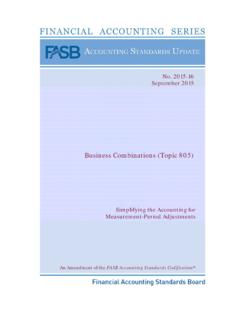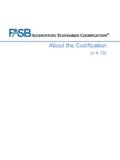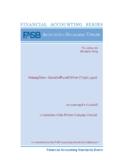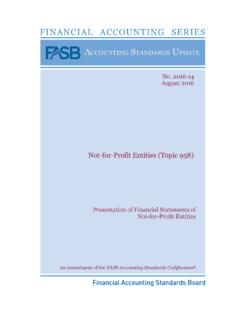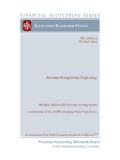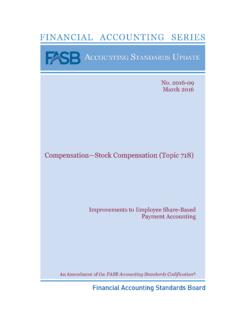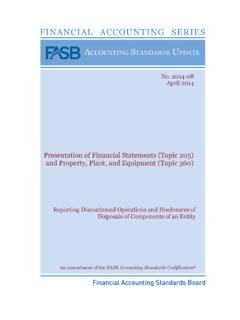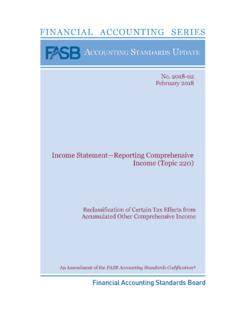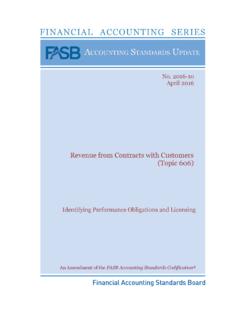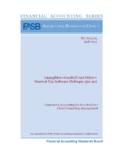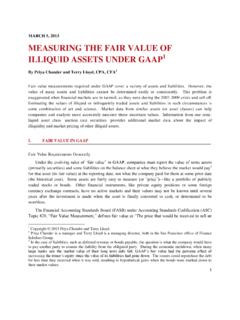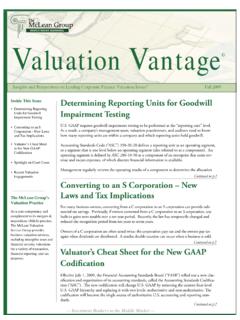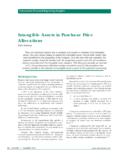Transcription of ASU 2011-04 Fair Value Measurement Topic 820 ... - FASB
1 fair Value Measurement ( Topic 820) No. 2011-04 May 2011 Amendments to Achieve Common fair Value Measurement and Disclosure Requirements in GAAP and IFRSs The FASB Accounting Standards Codification is the source of authoritative generally accepted accounting principles (GAAP) recognized by the FASB to be applied by nongovernmental entities. An Accounting Standards Update is not authoritative; rather, it is a document that communicates how the Accounting Standards Codification is being amended. It also provides other information to help a user of GAAP understand how and why GAAP is changing and when the changes will be effective. For additional copies of this Accounting Standards Update and information on applicable prices and discount rates contact: Order Department Financial Accounting Standards Board 401 Merritt 7 PO Box 5116 Norwalk, CT 06856-5116 Please ask for our Product Code No. ASU2011-04.
2 FINANCIAL ACCOUNTING SERIES (ISSN 0885-9051) is published quarterly by the Financial Accounting Foundation. Periodicals postage paid at Norwalk, CT and at additional mailing offices. The full subscription rate is $230 per year. POSTMASTER: Send address changes to Financial Accounting Standards Board, 401 Merritt 7, PO Box 5116, Norwalk, CT 06856-5116. | No. 362 Copyright 2011 by Financial Accounting Foundation. All rights reserved. Content copyrighted by Financial Accounting Foundation may not be reproduced, stored in a retrieval system, or transmitted, in any form or by any means, electronic, mechanical, photocopying, recording, or otherwise, without the prior written permission of the Financial Accounting Foundation. Financial Accounting Foundation claims no copyright in any portion hereof that constitutes a work of the United States Government. An Amendment of the FASB Accounting Standards Codification No.
3 2011-04 May 2011 fair Value Measurement ( Topic 820) Amendments to Achieve Common fair Value Measurement and Disclosure Requirements in GAAP and IFRSs Accounting Standards Update Financial Accounting Standards Boardof the Financial Accounting Foundation401 MERRITT 7, PO BOX 5116, NORWALK, CONNECTICUT 06856-5116 Accounting Standards Update 2011-04 fair Value Measurement ( Topic 820) Amendments to Achieve Common fair Value Measurement and Disclosure Requirements in GAAP and IFRSs May 2011 CONTENTS Page Numbers Summary .. 1 8 Amendments to the FASB Accounting Standards Codification .. 9 161 Background Information and Basis for Conclusions ..162 190 Topic 820 as Amended by This Update .. 191 275 Amendments to the XBRL Taxonomy .. 276 325 Summary Why Is the FASB Issuing This Accounting Standards Update (Update)? In 2006, the FASB and the International Accounting Standards Board (IASB) published a Memorandum of Understanding, which has served as the foundation of the Boards efforts to create a common set of high quality global accounting standards.
4 Consistent with the Memorandum of Understanding and the Boards commitment to achieving that goal, the amendments in this Update are the result of the work by the FASB and the IASB to develop common requirements for measuring fair Value and for disclosing information about fair Value measurements in accordance with generally accepted accounting principles (GAAP) and International Financial Reporting Standards (IFRSs). The Boards worked together to ensure that fair Value has the same meaning in GAAP and in IFRSs and that their respective fair Value Measurement and disclosure requirements are the same (except for minor differences in wording and style). The Boards concluded that the amendments in this Update will improve the comparability of fair Value measurements presented and disclosed in financial statements prepared in accordance with GAAP and IFRSs. The amendments in this Update explain how to measure fair Value .
5 They do not require additional fair Value measurements and are not intended to establish valuation standards or affect valuation practices outside of financial reporting. Who Is Affected by the Amendments in This Update? The amendments in this Update apply to all reporting entities that are required or permitted to measure or disclose the fair Value of an asset, a liability, or an instrument classified in a reporting entity s shareholders equity in the financial statements. Some of the disclosures required by the amendments in this Update are not required for nonpublic entities. Those disclosures include the following: 1. Information about transfers between Level 1 and Level 2 of the fair Value hierarchy 2. Information about the sensitivity of a fair Value Measurement categorized within Level 3 of the fair Value hierarchy to changes in unobservable inputs and any interrelationships between those unobservable inputs 1 3.
6 The categorization by level of the fair Value hierarchy for items that are not measured at fair Value in the statement of financial position, but for which the fair Value of such items is required to be disclosed. What Are the Main Provisions? The amendments in this Update result in common fair Value Measurement and disclosure requirements in GAAP and IFRSs. Consequently, the amendments change the wording used to describe many of the requirements in GAAP for measuring fair Value and for disclosing information about fair Value measurements. For many of the requirements, the Board does not intend for the amendments in this Update to result in a change in the application of the requirements in Topic 820. Some of the amendments clarify the Board s intent about the application of existing fair Value Measurement requirements. Other amendments change a particular principle or requirement for measuring fair Value or for disclosing information about fair Value measurements.
7 How Do the Main Provisions Differ from Current Generally Accepted Accounting Principles (GAAP) and Why Are They an Improvement? The amendments in this Update change the wording used to describe the requirements in GAAP for measuring fair Value and for disclosing information about fair Value measurements. The amendments include the following: 1. Those that clarify the Board s intent about the application of existing fair Value Measurement and disclosure requirements 2. Those that change a particular principle or requirement for measuring fair Value or for disclosing information about fair Value measurements. In addition, to improve consistency in application across jurisdictions some changes in wording are necessary to ensure that GAAP and IFRS fair Value Measurement and disclosure requirements are described in the same way (for example, using the word shall rather than should to describe the requirements in GAAP).
8 The amendments that clarify the Board s intent about the application of existing fair Value Measurement and disclosure requirements include the following: 1. Application of the highest and best use and valuation premise concepts. The amendments specify that the concepts of highest and best use and valuation premise in a fair Value Measurement are relevant only when 2 measuring the fair Value of nonfinancial assets and are not relevant when measuring the fair Value of financial assets or of liabilities. The Board decided that the highest and best use concept is not relevant when measuring the fair Value of financial assets or the fair Value of liabilities because such items do not have alternative uses and their fair values do not depend on their use within a group of other assets or liabilities. Before those amendments, Topic 820 specified that the concepts of highest and best use and valuation premise were relevant when measuring the fair Value of assets, but it did not distinguish between financial and nonfinancial assets.
9 The Board concluded that the amendments do not affect the fair Value Measurement of nonfinancial assets and will improve consistency in the application of the highest and best use and valuation premise concepts in a fair Value Measurement . The amendments might affect practice for some reporting entities that were using the in-use valuation premise to measure the fair Value of financial assets, as described below in the section Measuring the fair Value of financial instruments that are managed within a portfolio. 2. Measuring the fair Value of an instrument classified in a reporting entity s shareholders equity. The amendments include requirements specific to measuring the fair Value of those instruments, such as equity interests issued as consideration in a business combination. Those amendments are consistent with the requirements for measuring the fair Value of liabilities and specify that a reporting entity should measure the fair Value of its own equity instrument from the perspective of a market participant that holds that instrument as an asset.
10 Before those amendments, Topic 820 stated that the definition of fair Value should be applied to an instrument measured at fair Value that is classified in shareholders equity, but it did not contain explicit requirements for measuring the fair Value of such instruments. The Board concluded that including requirements on how to apply the principles of Topic 820 when measuring the fair Value of an instrument classified in a reporting entity s shareholders equity will improve consistency in application and will increase the comparability of fair Value measurements among reporting entities applying GAAP or IFRSs. The Board does not expect those amendments to affect current practice. 3. Disclosures about fair Value measurements. The amendments clarify that a reporting entity should disclose quantitative information about the unobservable inputs used in a fair Value Measurement that is categorized within Level 3 of the fair Value hierarchy.
